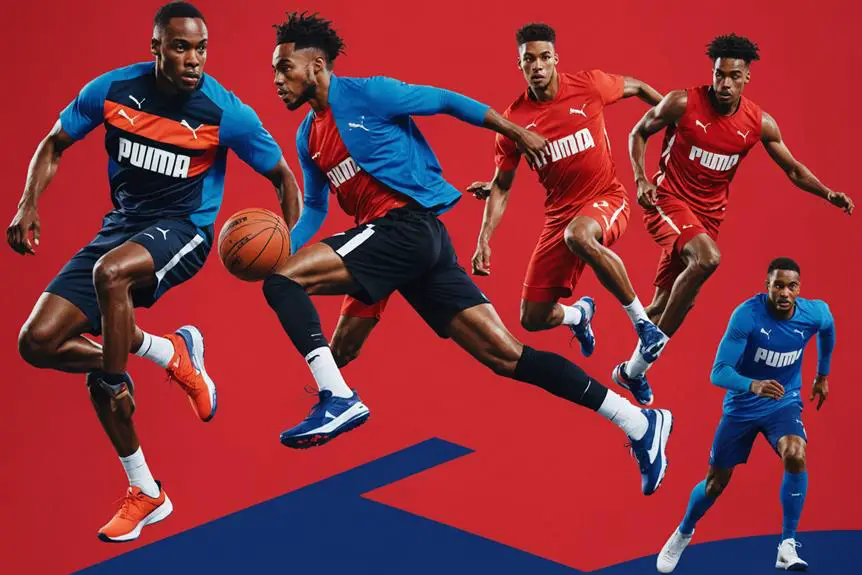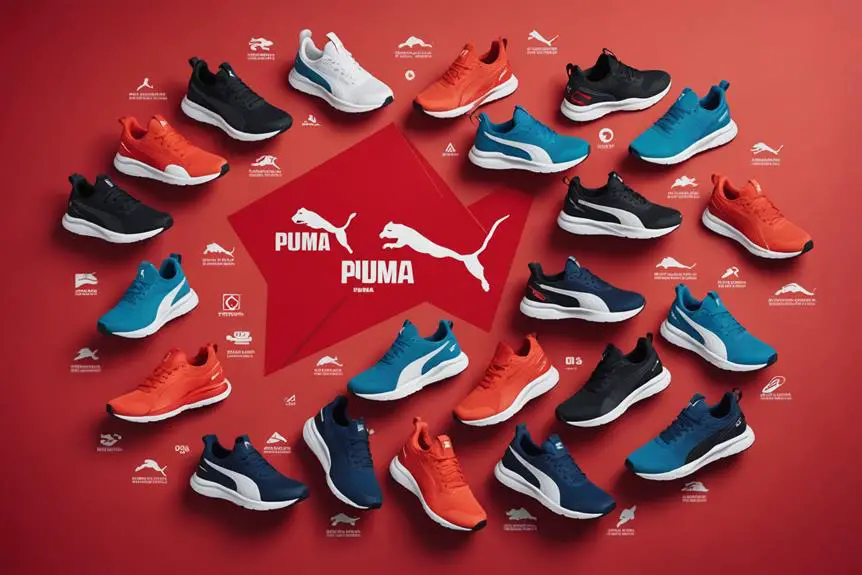Puma's history marks a dramatic evolution from its 1948 inception by Rudolf Dassler in Germany to a global fashion icon. Initially registered as RuDa, the brand quickly gained recognition for its stylish designs and innovations like the FORMSTRIP logo and the RS-Computer sneaker. Puma built credibility through collaborations with fashion influencers and celebrities, enhancing its appeal in the lifestyle sector. Strategic partnerships, including its long-term alliance with renowned fashion houses, further solidified its presence in the fashion market. Emphasizing sustainability, the company has committed to eco-friendly practices, achieving significant reductions in carbon emissions. If you explore further, you'll uncover more layers of Puma's remarkable journey and its impact on fashion culture.
The Founding of Puma

The founding of Puma marks a pivotal moment in the history of sportswear, emerging from the competitive landscape created by the Dassler brothers' earlier partnership. Rudolf Dassler established Puma on January 23, 1948, in Herzogenaurach, Germany, after a split from his brother Adi, who would go on to create Adidas. Initially registered as RuDa, Puma began with just 15 employees, highlighting a modest start for a brand that would soon gain global prominence.
On October 1, 1948, Puma was officially registered at the German Patent and Trademark Office, solidifying its identity in the competitive sports footwear market. By December of that year, the name changed to PUMA Schuhfabrik Rudolf Dassler, signaling a clear commitment to developing innovative athletic footwear. This change laid the groundwork for what would become a powerhouse brand in the sportswear industry.
As Puma grew, its workforce expanded considerably, eventually exceeding 14,000 employees prior to its 75th anniversary in 2023. This growth reflects not only the brand's success but also its historical significance rooted in the legacy of the Gebrüder Dassler Schuhfabrik and the competitive spirit that defined its early years.
Key Innovations in Footwear
As Puma ventured into the competitive sportswear market, it quickly became a beacon of innovation in footwear design and technology. One of its groundbreaking introductions was the SUPER ATOM in 1952, a football boot that featured screw-in studs, fundamentally enhancing performance on the field. This innovation set a new standard for traction and stability, allowing athletes to excel during play.
In 1958, the patented FORMSTRIP logo emerged, not only as a distinctive branding element but also as a functional feature that improved shoe stability. Fast forward to 1985, when Puma launched the Running System (RS), which ingeniously combined various components for superior shock absorption and motion control, elevating the running experience.
The following year, Puma took a monumental leap with the RS-Computer, the first computerized sneaker, empowering runners to track and analyze their performance metrics. Then in 1991, the DISC System technology revolutionized lacing mechanisms, providing athletes with quicker, more precise adjustments for ideal fit. Each of these innovations underscores Puma's commitment to enhancing athletic performance through cutting-edge technology, setting the brand apart in the footwear industry.
Notable Athlete Endorsements

Puma's success in the sportswear industry is heavily intertwined with its strategic endorsements of notable athletes, which have greatly shaped its brand identity and market presence. Starting with Jesse Owens, who captured four gold medals at the 1936 Olympics wearing Dassler spikes, Puma established itself as a leader in competitive sports early on. This legacy continued in 1968 when Puma signed Eusebio, the top scorer of the 1966 World Cup, who donned Puma boots, solidifying the brand's prominence in football.
Usain Bolt, widely recognized as the fastest man in the world, became a key ambassador for Puma in 2002. His record-breaking performances in Puma track spikes further elevated the brand's image. Additionally, tennis legend Boris Becker contributed to Puma's popularity by winning Wimbledon at just 17 in 1985 while wearing Puma shoes, showcasing the brand's commitment to excellence across sports.
These strategic athlete endorsements not only enhanced Puma's credibility but also forged emotional connections with fans. As Puma continues to evolve, these historical partnerships underscore its dedication to performance, innovation, and cultural relevance within the sporting world.
Strategic Partnerships and Branding
Strategic partnerships have been pivotal in shaping Puma's brand identity and expanding its market reach across various sports and lifestyle segments. For instance, the long-term partnership with Borussia Dortmund, initiated in 2012 and extending to 2028, solidifies PUMA's influence in the football industry, enhancing its visibility among fans and athletes alike. The brand's "FOREVER. FASTER." campaign, launched in 2014, showcased high-profile athletes like Usain Bolt, greatly bolstering Puma's branding within the competitive sports community.
PUMA's re-entry into the basketball market in 2018, under the guidance of Creative Director Jay-Z, exemplifies its strategic commitment to diversifying its portfolio and amplifying its market appeal. Historical moves, such as the "Pelé Pact" in 1970, where PUMA signed the legendary footballer despite an agreement with Adidas, generated massive publicity, positioning the brand prominently during the World Cup.
Moreover, collaborations with cultural icons like Rihanna and The Weeknd have further shaped Puma's identity, blending sport and fashion, and attracting a broader audience. These partnerships not only elevate PUMA's market influence but also guarantee its relevance in a constantly evolving industry.
Financial Overview and Growth

A thorough financial overview reveals Puma's dynamic growth trajectory and resilience in a competitive market. As a public company listed on the Frankfurt Stock Exchange, Puma has navigated various financial challenges while maintaining robust sales and strategic acquisitions. Under the leadership of former CEO Bjørn Gulden from 2013 to November 2022, the brand underwent significant transformation, which contributed to its growth.
Here are some key financial highlights:
- In 1986, Puma became a public company, marking its entry into the global financial arena.
- Kering holds a 9.8% stake in Puma, with Groupe Artemis owning 29% of its share capital, showcasing strong investment backing.
- Despite a 26% drop in profits in February 2007, sales continued to rise, demonstrating resilience against financial challenges.
- The acquisition of Cobra Golf in 2010 allowed Puma to expand into the lucrative global golf equipment market.
As of 2022, Puma employed over 18,000 people, reflecting its extensive operational scale and strong market presence, poised for continued growth amid evolving industry demands.
Sustainability and Ethical Practices
In the domain of sustainability and ethical practices, Puma has positioned itself as a pioneer, taking bold steps to address its environmental impact and labor conditions. You'll find it remarkable that Puma was the first major company to quantify its environmental impact back in 2011. By 2015, it aimed to achieve 50% sustainable materials in its collections. The brand has reported an impressive 88% reduction in carbon emissions globally from 2017 to 2021 and banned kangaroo leather in 2023, now incorporating 20% recycled material into its products.
Puma's commitment to ethical practices extends to its supply chain, conducting annual supplier audits since 2000 to improve labor practices, especially after uncovering poor conditions in some factories. The recent launch of the "Voices of a Re:Generation" initiative in April 2023 aims to integrate youth perspectives into its sustainability strategies, further solidifying its role as a climate leader. Recognized by the Financial Times, Puma stands out in the corporate world for its dedication to sustainability, making significant strides in reducing its environmental footprint while ensuring ethical practices throughout its operations.
Frequently Asked Questions
What Is the History of Puma?
When exploring Puma's history, you'll find a blend of innovation, rivalry, and iconic design. The brand's evolution features groundbreaking products, influential collaborations, and a commitment to performance that resonates deeply within the athletic community today.
What Is the Meaning Behind Puma?
The name "Puma" embodies speed, agility, and power, reflecting your pursuit of athleticism. The leaping logo symbolizes dynamism, while the Formstrip enhances shoe stability, representing innovation and commitment to performance in your sporting endeavors.
Which Is Bigger Adidas or Puma?
Adidas is considerably bigger than Puma, boasting higher revenues, market capitalization, and a larger workforce. With Adidas generating around €21.2 billion compared to Puma's €6.8 billion, the difference in scale is considerable.
What Is a Fact About Puma Brand?
Puma's iconic formstrip logo, patented in 1958, not only enhances shoe stability but also signifies the brand's innovative approach to design. You'll find it prominently featured on many of their popular athletic products today.




Your article helped me a lot, is there any more related content? Thanks!
Thanks for sharing. I read many of your blog posts, cool, your blog is very good.